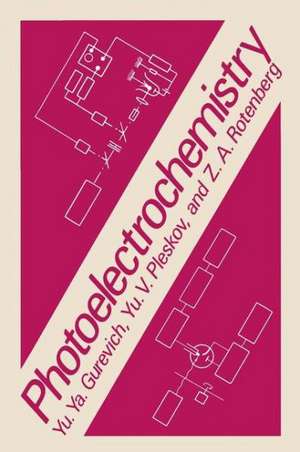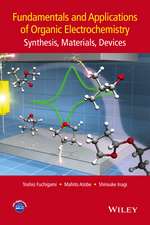Photoelectrochemistry
Editat de Yu. Gurevichen Limba Engleză Paperback – 8 oct 2011
Preț: 385.47 lei
Nou
Puncte Express: 578
Preț estimativ în valută:
73.76€ • 77.02$ • 60.91£
73.76€ • 77.02$ • 60.91£
Carte tipărită la comandă
Livrare economică 15-29 aprilie
Preluare comenzi: 021 569.72.76
Specificații
ISBN-13: 9781461339328
ISBN-10: 1461339324
Pagini: 260
Ilustrații: XVI, 240 p.
Dimensiuni: 152 x 229 x 14 mm
Greutate: 0.35 kg
Ediția:Softcover reprint of the original 1st ed. 1980
Editura: Springer Us
Colecția Springer
Locul publicării:New York, NY, United States
ISBN-10: 1461339324
Pagini: 260
Ilustrații: XVI, 240 p.
Dimensiuni: 152 x 229 x 14 mm
Greutate: 0.35 kg
Ediția:Softcover reprint of the original 1st ed. 1980
Editura: Springer Us
Colecția Springer
Locul publicării:New York, NY, United States
Public țintă
ResearchCuprins
0.1. Historical Background.- 0.2. Stages of Photoelectron Emission into Solution.- 0.3. General Features of Emission Phenomena in Electrochemical Systems.- 1. Fundamentals of the Theory of Photoelectron Emission from Metals into Solutions.- 1.1. Qualitative Description of the Phenomenon.- 1.2. The Threshold Approach to Photoemission.- 1.3. Calculation of the Photoemission Current.- 1.4. The 5/2 Power Law.- 1.5. The Effects of the Double Layer on the Photoemission.- 1.6. Dependence of the Photoemission Current on the Characteristics of the Irradiation.- 2. Theory of Photodiffusion Currents.- 2.1. Formulation of the Problem and Basic Relations.- 2.2. Stationary Photodiffusion Currents.- 2.3. Alternating Photodiffusion Currents.- 3. Experimental Techniques in Photoemission Studies.- 3.1. General Discussion of Photocurrent Measurements.- 3.2. Measuring Apparatus.- 3.3. Electrode Illumination.- 3.4. Electrochemical Cells.- 3.5. The Choice of Acceptors for Solvated Electrons.- 4. Photoelectron Emission in Solutions: Its Discovery, Kinetics, and Energetics.- 4.1. Introductory Notes.- 4.2. The Dependence of the Photoemission Current on the Electrode Potential and Quantum Energy. Experimental Verification of the 5/2 Power Law.- 4.3. The Effect of the Nature of the Metal on Photoemission and Electrochemical Kinetics.- 4.4. Energetics of Excess Electrons in Polar Solvents.- 4.5. The Effect of the Light Frequency and Polarization. Bulk andSurface Excitation of Electrons.- 4.6. Multiphoton Emission.- 5. Emitted Electrons in Solution: Subsequent Transformations.- 5.1. Dependence of the Photocurrent on Acceptor Concentration.- 5.2. Is There a Contribution of “Dry” Electrons to Photodiffusion Currents?.- 5.3. Characteristics of Retardation and Hydration of Photoelectrons.- 5.4.Slow Capture of Hydrated Electrons by the Metal Surface.- 5.5. Measurements of the Rate Constants of Electron Capture by Acceptors.- 5.6. Method of Competing Acceptors in Photoemission Studies.- 6. Investigation of the Structure of the Electric Double Layer Using the Photoemission Method.- 6.1. The Role of the Diffuse Layer in Photoemission Phenomena; General Considerations.- 6.2. Dependence of the Photocurrent on Electrolyte Concentration.- 6.3. Measurement of the Potential of Zero Charge by a Photoemission Method.- 6.4. Direct Experimental Determination of the ? Potential.- 6.5. Investigation of Specific Adsorption.- 6.6. Evaluation of the Thickness of the Compact Layer.- 7. Photoemission As a Method of Investigation of Electrochemical Kinetics: Processes Involving Atomic Hydrogen.- 7.1. Formation of Atomic Hydrogen in Electrochemical Reactions. Phenomenology and Empirical Equations.- 7.2. Basic Experimental Data Concerning Atomic Hydrogen Reactions.- 7.3. The Role of the Adsorption Stage.- 7.4. The Mechanism of Atomic Hydrogen Reactions on Mercury Electrodes.- 7.5. The Mechanism of Atomic Hydrogen Reactions at Bismuth and Other Solid Electrodes.- 7.6. The Effect of the Double Layer on the Kinetics of Atomic Hydrogen Reactions.- 8. Photoemission As a Method of Investigating Homogeneous Reactions Involving Free Radicals.- 8.1. Chemical and Electrochemical Reactions of the Radical Anion NO32-.- 8.2. Chemical and Electrochemical Reactions Involving CO2? and CH3° Radicals.- 8.3. Chemical Reactions of H and OH Radicals with Alcohols and Other Organic Compounds.- 8.4. Multielectron Electrochemical Reactions Initiated by Photoemission.- 9. Photoelectron Emission from Semiconductors into Solutions and from Solutions into the Vapor Phase.- 9.1. Qualitative Description ofPhotoemission from Semiconductors.- 9.2. Calculation of the Photoemission Current at Semiconductor Electrodes.- 9.3. Photoemission from Semiconductor Electrodes: Experimental.- 9.4. Photoelectron Emission from Solutions into the Vapor Phase. Schematic Aspects of the Process.- 9.5. Principles of the Theory of Photoelectron Emission from Solutions.- 9.6. Photoelectron Emission from Solutions. Basic Experimental Results.- 10. Specific Problems of Photoelectrochemical Phenomena.- 10.1. Currents of Photoelectrochemical Reactions.- 10.2. Currents of the Pulse Warm-Up of the Electrode.- 10.3. Cathodic Generation of Solvated Electrons. Is the Solvated Electron an Intermediate in Cathodic Reactions?.- 10.4. Photoelectrochemical Effects Due to Surface Plasmons.- 10.5. Photoemission into Various Media.- 11. Perspectives of Photoemission Studies.- Appendixes.- References.










